Panel 1
Daniela Antonietti, Elvira Gatta
The collected data provide an overview of the training offer on specialised environmental topics provided by the National System for Environmental Protection (SNPA), composed of the Regional and Provincial Environmental Agencies (ARPA/APPA) and ISPRA. This offer includes both training courses and work-study pathways (curricular and extra-curricular internships, and the Paths for Transversal Skills and Orientation – PCTO). In 2024, compared to the previous year, there was a significant increase in the number of environmental training courses activated within the SNPA (304). Regarding training methodologies, the trend observed in previous years towards offering residential training courses continued, likely due to the normalisation of the post-COVID-19 health situation. The internships (both curricular and extra-curricular) activated during 2024 totalled 348 (of which only 9 were extra-curricular), while the number of PCTO students reached 2,796. Compared to 2023, there was a significant increase in training delivered through internships (+22.1%) as well as through PCTO (+38.6%).
The indicator provides an overview of the training offer on environmental topics provided by the National System for Environmental Protection (SNPA), consisting of the network of Regional and Provincial Environmental Agencies (ARPA/APPA) and ISPRA. The indicator takes into account training courses aimed at technical staff of the Agencies and ISPRA, as well as external technical personnel. The data related to training courses include the number of participants, divided according to their affiliation with the Agencies and ISPRA or external to them; the number of training hours delivered; and the number of courses funded by internal and external resources of the Agencies and ISPRA. The main thematic areas covered by the training are also highlighted. Data on the environmental training offer also refer to internship programmes targeted at university graduates and recent graduates, activated under agreements with universities or higher education institutions; and to students of secondary schools through the activation of Paths for Transversal Skills and Orientation (PCTO) for students in the final three years of upper secondary schools, made compulsory by the reform of the “Good School” under Law 107/2015 and subsequently amended by the 2019 Budget Law. For internships and PCTO, the information includes the number of internships and training pathways activated, topics covered, and types of internships (curricular and extra-curricular).
Provide a framework overview of the environmental training offer promoted by the SNPA (ISPRA-ARPA/APPA).
-
Law 13 July 2015, No. 107, “Reform of the National Education and Training System and Delegation for the Reorganisation of Existing Legislative Provisions”
-
Law 28 June 2016, No. 132, “Establishment of the National Network System for Environmental Protection and Regulation of the Higher Institute for Environmental Protection and Research”
-
2019 Budget Law, 30 December 2018, No. 145
The reference regulations do not set any specific targets.
Panel 2
-
European Commission, GreenComp – European sustainability competence framework, 2022
-
Directive of the Minister of the Department of Public Administration – Enhancing people and generating public value through training. Principles, objectives and tools, January 2025
-
Commission Recommendation (EU) 2017/761 of 26 April 2017 on the European Pillar of Social Rights
-
Recommendation of the European Parliament and of the Council of 22 May 2018 on key competences for lifelong learning
-
Council Recommendations of 16 June 2022 on learning for the green transition and sustainable development
-
Council Recommendations of 19 December 2016 on pathways to improve skills levels: new opportunities for adults
-
National Strategy for Sustainable Development, Ministry for the Environment, Land and Sea Protection (MATTM), 2022
-
National Strategy for Sustainable Development, Ministry for the Environment, Land and Sea Protection (MATTM), 2023
-
UNECE Strategy for Education for Sustainable Development, 2005
The indicator refers solely to data collected within the National System for Environmental Protection (ISPRA-ARPA/APPA) and should be extended to include the entire range of bodies and institutions involved in environmental training.
Update of the indicator with agreed changes and additions within the SNPA and with other bodies involved in environmental training.
Data quality assessment
SNPA (Sistema Nazionale per la protezione dell’ambiente)
Data from the SNPA (ISPRA-ARPA/APPA) are used, collected through questionnaire administration.
National, regional
2017-2024
Indicator assessment
The indicator related to the environmental training offer is obtained through:
-
the total number of training courses delivered;
-
the total number of training hours provided;
-
the total number of participants;
-
the calculation of average training hours per course;
-
the calculation of average participants per course;
-
the percentage distribution of thematic areas covered in the courses;
-
the total number of internships;
-
the total number of participants in the Paths for Transversal Skills and Orientation (PCTO);
-
the percentage distribution of thematic areas covered by the internships;
-
the percentage distribution of thematic areas covered by the Paths for Transversal Skills and Orientation.
In 2024, 304 courses on environmental topics were recorded, involving 15,056 participants and delivering 15,768 hours of training (Table 1). Training internships on environmental topics saw a significant increase compared to the previous year (+22.1%), rising from 285 to 348 (Table 3). The number of students trained through the educational methodology of the Paths for Transversal Skills and Orientation (PCTO) reached 2,796, compared to 2,017 in 2023, an increase of 38.6%. Conversely, new agreements signed with the involved schools decreased (-29.7%), from 148 to 104 (Table 4). However, this reduction did not result in a decline in the number of students involved. Overall, therefore, the situation can be described as good.
During the monitored period (2017–2024), despite some fluctuations, particularly in the last three years, the overall trend showed a steady expansion of training activities (Table 1). Therefore, the trend of the environmental training offer provided by the SNPA can be described as positive, both in quantitative terms and in relation to the diversification of the training methods employed. In particular, the total number of environmental training hours delivered exhibited an increasing trend, with a significant rise compared to 2017, from 2,065 to 15,768 (Figure 3).
Data
Table 1: Environmental training courses delivered
Source: ISPRA elaboration using SNPA data
Table 2: Recipients of environmental training courses
Source: ISPRA elaboration using SNPA data
Table 3: Environmental training internships and placements
Source: ISPRA elaboration using SNPA data
Table 4: Paths for Transversal Skills and Orientation on Environmental Topics
Source: ISPRA elaboration using SNPA data
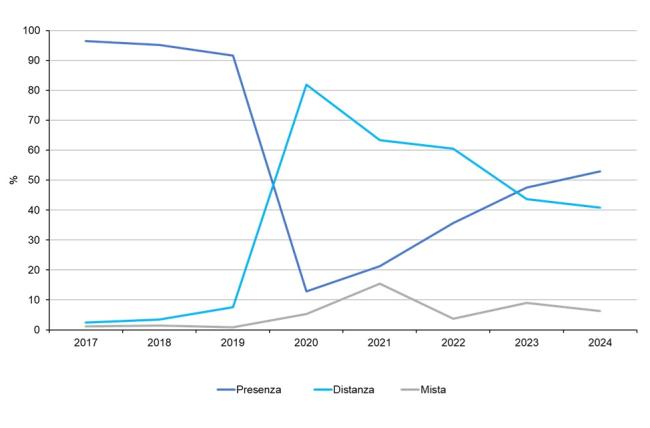
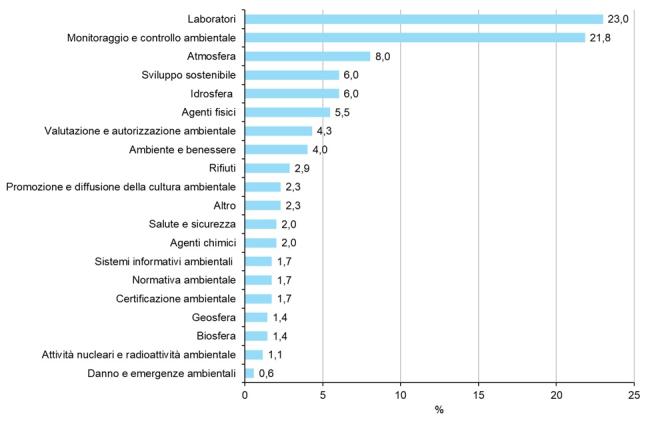
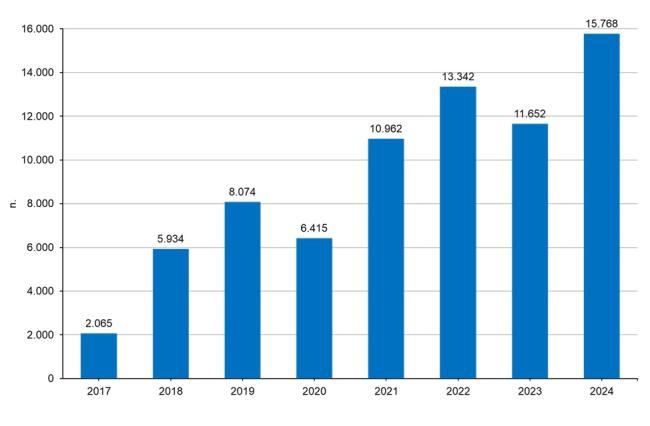
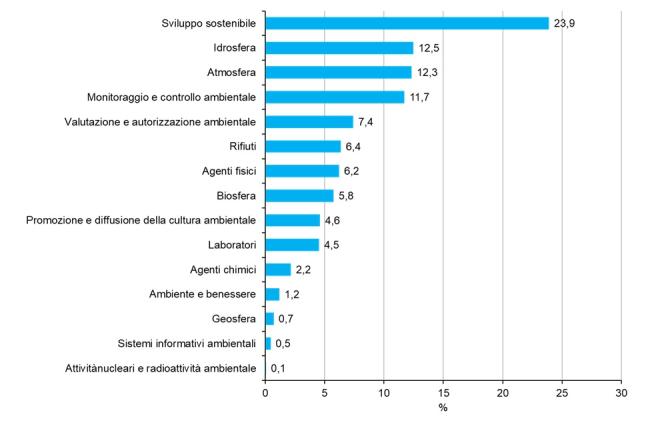
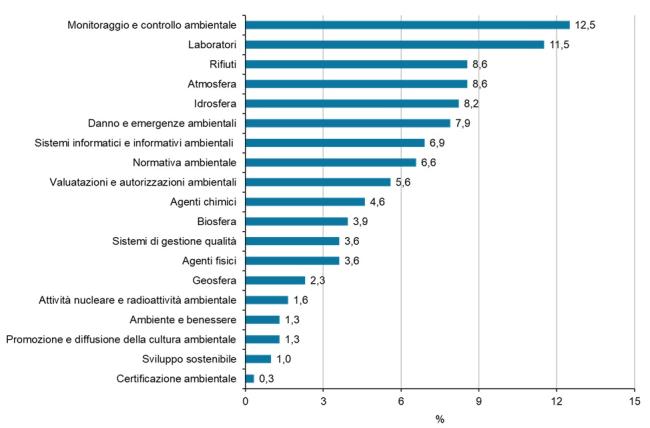
Distance learning methodologies ensured the continuity of the training offer for both internal and external SNPA operators even during the health emergency caused by the spread of COVID-19. However, with the gradual resolution of the emergency, the last three years have seen a marked return to in-person training (Figure 1). Training activities are mainly aimed at updating and enhancing the skills of internal staff within the System, although the trend since 2017 has shown an increasing openness towards external participants (Table 2). In 2024, external participants (3,418) represent approximately 23% of the total trainees, which amount to 15,056 individuals (Table 2). The variety of topics addressed reflects the breadth of SNPA’s activity sectors. In particular, in 2024, the predominant course topics are: "Environmental Monitoring and Control" (12.5%), "Laboratories" (11.5%), "Waste" and "Atmosphere" (8.6%), and "Hydrosphere" (8.2%) (Figure 5). Regarding the Paths for Transversal Skills and Orientation (PCTO), aimed at students in the last three years of secondary school, the most popular topics in 2024 are: "Sustainable Development" (23.9%), "Hydrosphere" (12.5%), and "Atmosphere" (12.3%) (Figure 4). Internships and placements mainly cover the areas of "Laboratories" (23%) and "Environmental Monitoring and Control" (22.8%) (Figure 2). The ratio between curricular and extra-curricular internships remains stable, with the former representing 97% of the total and the latter 3%. In absolute terms, 9 extra-curricular internships were activated compared to 339 curricular internships (Table 3).